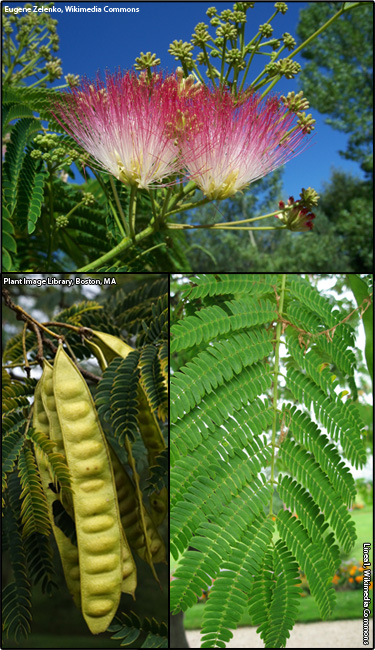Silktree (Albizia julibrissin)
 Common Names: Mimosa, silk tree
Common Names: Mimosa, silk treeDescription: Introduced in 1745 as an ornamental.
Habit: Deciduous, leguminous tree that can grow up to 10-50 feet tall.
Leaves: Fern-like, finely divided, 5-8 inches long by 3-4 inches wide, alternate along the stems.
Stems: Bark is light brown in color, nearly smooth and generally thin with lens shaped areas along the stem.
Flowers: Showy, fragrant, pink in color, 1.5 inches long, resemble pom-poms and arranged in panicles at the ends of branches.
Fruit and seeds: Flat, straw colored pods, 6 inches long containing light brown, oval-shaped seeds that are about 0.5 in. long.
Habitat: Native to Asia. Can be found along roadsides, open vacant lots, stream banks, and riparian areas.
Reproduction: By seed and vegetatively.
Monitoring and rapid response: Seedlings can be effectively controlled by handpulling. Cutting and repeated cutting for sprout and girdling for larger trees. Can be effectively controlled using any of several readily available general use herbicides such as glyphosate or triclopyr. Credits: The information provided in this factsheet was gathered from the U.S. Department of Agriculture, Forest Service Weed of the Week 12-13-04.
Individual species images that appear with a number in a black box are courtesy of the Bugwood.org network (http://www.invasive.org). Individual photo author credits may not be included due to the small display size of the images and subsequent difficulty of reading the provided text. All other images appear courtesy of Google (http://images.google.com).
